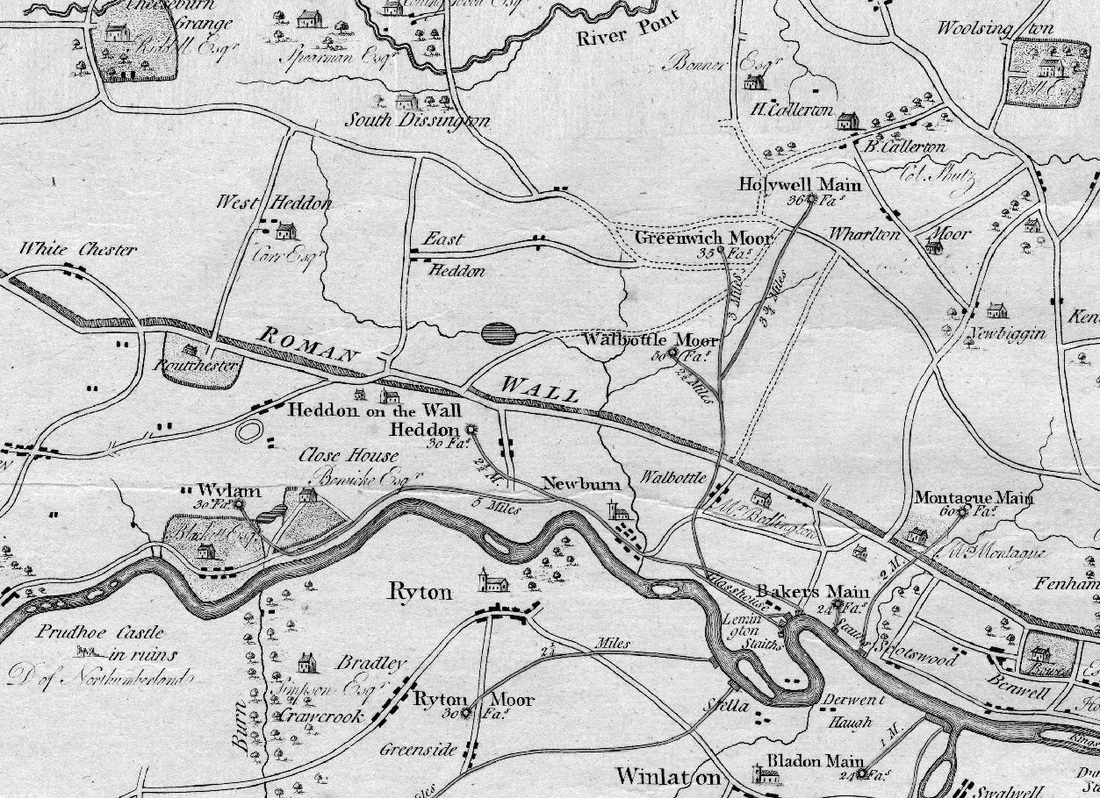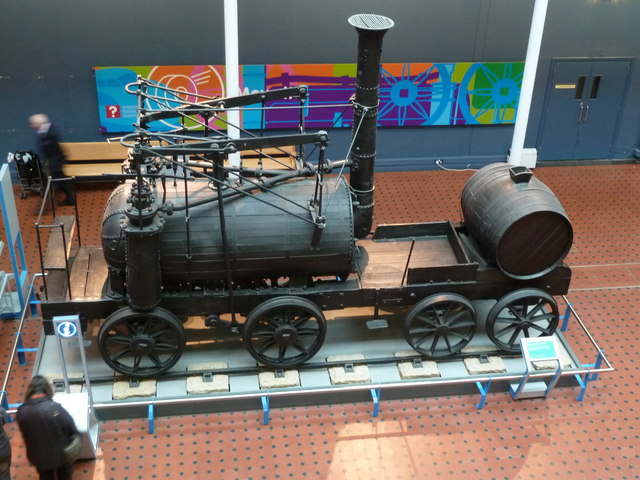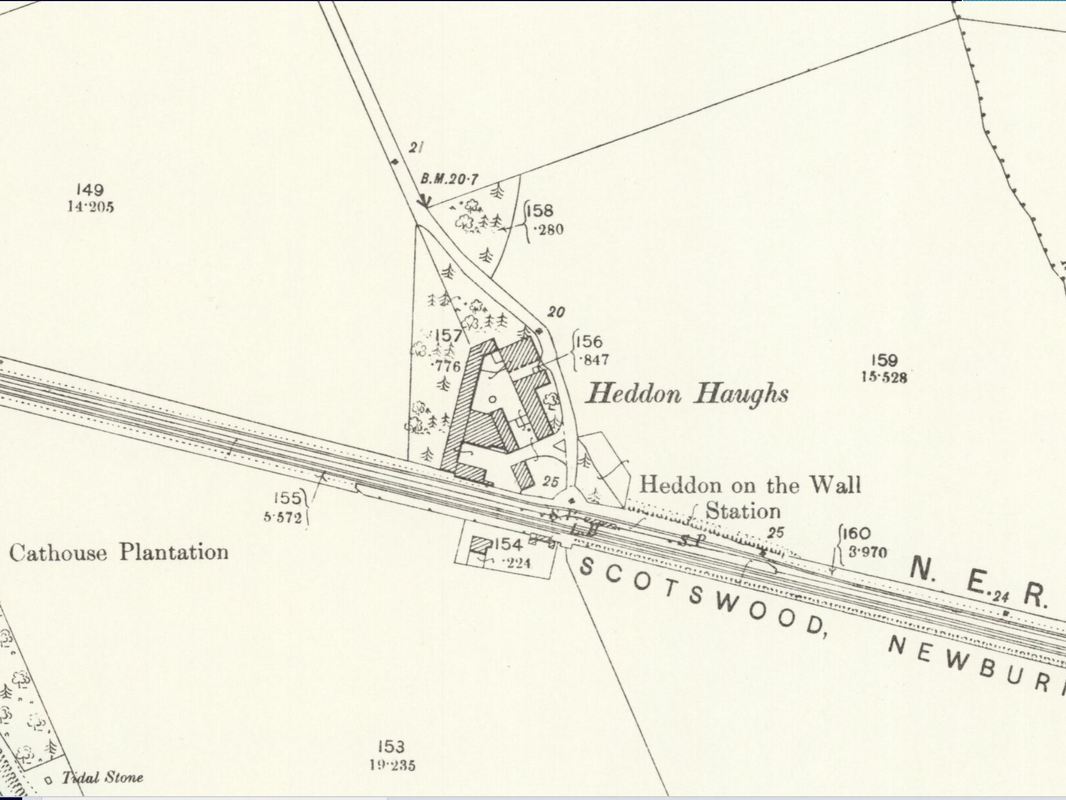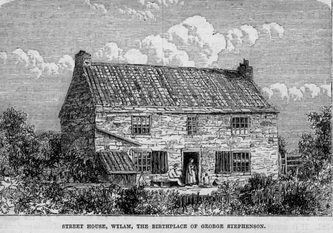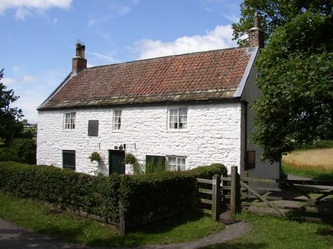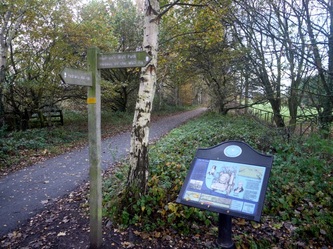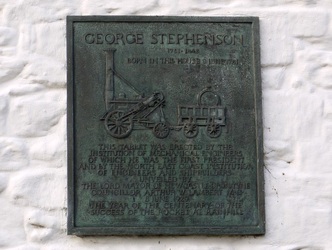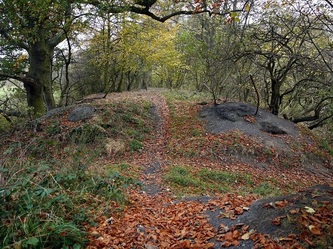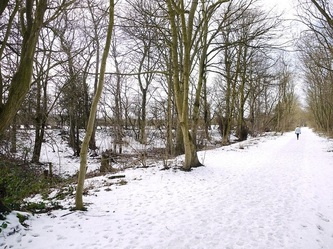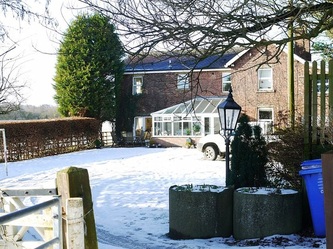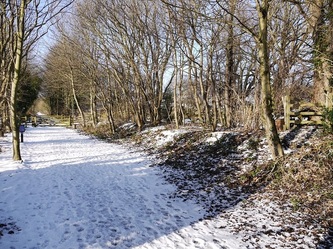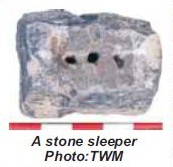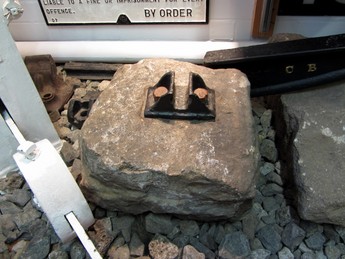Wagonway & Railway
based on an article by Pat Farnaby
The Wylam Waggonway was built around 1748 to a five foot gauge, and was used to transport coal from Wylam to Lemington for shipment down the River Tyne.
Originally the coal wagons were pulled by horses along the wooden rails. In 1808 the wooden rails were replaced with iron rails. During the period of the the Napoleonic Wars (1799 - 1815), when demand for coal was high, Mr Christopher Blackett, the owner of Wylam Colliery, wanted to improving the transport of coal. In 1812 he asked his Colliery Manager, William Hedley, to build a locomotive. Hedley produced a prototype which went into operation in 1813. By 1815 Hedley's steam engines were established on the Waggonway pulling eight wagons as against the single wagon originally pulled by a horse.
Map section taken from Durham University: Pictures in Print Link
|
George Stephenson introduced the dandy waggon in 1828, which was simply a four-wheeled cart supplied with hay, attached to the rear of a four-chaldron train in which the horse could rest on the downhill sections. It was said that if the dandy waggon was missing the horse would try to jump onto the rearmost chaldron. |
_
William Hedley, who was born at Newburn, had an innovative theory that if the locomotives wheels were coupled, the weight of the locomotive alone would provide adequate grip for smooth wheels to run on smooth rails.
Although George Stephenson is well known for the development of steam locomotives his engine was not produced until 1814, one year after Hedley's. Stephenson's Cottage stands by the line of the old Waggonway. and like the neighbouring terrace, Street Houses, it lies just outside Heddon Parish, in Wylam. The cottage was placed in the hands of the National Trust in 1948 exactly a century after Stephenson's death; a square metal plaque with a relief of his famous locomotive, 'Rocket' adorns the front wall.
Willam Hedley is best remembered for his two famous engines, "Puffing Billy" and "Wylam Dilly". The latter took it's name from the Waggonway and was often referred to as the "Dilly". Puffing Billy, began working on the five-mile Wylam Waggonway in about 1813. It was to continue in use, much rebuilt, until 1862.
In 1822 the "Wylam Dilly" was mounted onto a tug and was used on the River Tyne in an attempt to break the Keelman's strike. 1837 the Railway bridge was constructed at Wylam, this provided a link with the developing Newcastle to Carlisle railway, enabling coal to be transported directly to ships at the mouth of the River Tyne.
The closure of the Wylam Colliery in 1868 resulted in the Waggonway having very little use, until the Scotswood via Heddon to Wylam railway line opened in 1885 this followed part of the Waggonway route.
This railway line closed in 1966 and the tracks were removed in 1972 and part of the route of the Waggonway was turned into a public bridleway.
William Hedley, who was born at Newburn, had an innovative theory that if the locomotives wheels were coupled, the weight of the locomotive alone would provide adequate grip for smooth wheels to run on smooth rails.
Although George Stephenson is well known for the development of steam locomotives his engine was not produced until 1814, one year after Hedley's. Stephenson's Cottage stands by the line of the old Waggonway. and like the neighbouring terrace, Street Houses, it lies just outside Heddon Parish, in Wylam. The cottage was placed in the hands of the National Trust in 1948 exactly a century after Stephenson's death; a square metal plaque with a relief of his famous locomotive, 'Rocket' adorns the front wall.
Willam Hedley is best remembered for his two famous engines, "Puffing Billy" and "Wylam Dilly". The latter took it's name from the Waggonway and was often referred to as the "Dilly". Puffing Billy, began working on the five-mile Wylam Waggonway in about 1813. It was to continue in use, much rebuilt, until 1862.
In 1822 the "Wylam Dilly" was mounted onto a tug and was used on the River Tyne in an attempt to break the Keelman's strike. 1837 the Railway bridge was constructed at Wylam, this provided a link with the developing Newcastle to Carlisle railway, enabling coal to be transported directly to ships at the mouth of the River Tyne.
The closure of the Wylam Colliery in 1868 resulted in the Waggonway having very little use, until the Scotswood via Heddon to Wylam railway line opened in 1885 this followed part of the Waggonway route.
This railway line closed in 1966 and the tracks were removed in 1972 and part of the route of the Waggonway was turned into a public bridleway.
|
© Copyright Chris Allen and licensed for reuse under this Creative Commons Licence
|
© Copyright Pauline Eccles and licensed for reuse under this Creative Commons Licence
|
Railway
The Newcastle to Carlisle railway line was incorporated in 1829 and
opened throughout the full route in 1839. At that time, the residents
of Heddon had to walk down to the river bank and catch the ferry boat
across the Tyne to join the train at Ryton station. See transport.
In July 1885 the branch line from Scotswood, via Heddon, to Wylam was opened, sparing the residents of Heddon the precarious trip over the Tyne. In 1877 three residents of Heddon had lost their lives in a ferry accident, while crossing the Tyne.
This 'Northern' line also included a spur which ran into the yard of the Margaret Pit and Heddon Brick Works.
Heddon station was closed in 1958, and demolished in 1959.
The "Northern" railway line was closed in 1966 and the tracks were removed in 1972. Part of the route was turned into a public bridleway.
In July 1885 the branch line from Scotswood, via Heddon, to Wylam was opened, sparing the residents of Heddon the precarious trip over the Tyne. In 1877 three residents of Heddon had lost their lives in a ferry accident, while crossing the Tyne.
This 'Northern' line also included a spur which ran into the yard of the Margaret Pit and Heddon Brick Works.
Heddon station was closed in 1958, and demolished in 1959.
The "Northern" railway line was closed in 1966 and the tracks were removed in 1972. Part of the route was turned into a public bridleway.
Links
Waggonways - Waggonways of north-east England
The Pont Valley Network - wooden waggonways
Disused Stations - Heddon on the Wall
Where Railways were born: The story of Wylam and its Railway Pioneers
Northumbrian Railways - Wylam Waggonway
Hadrian's Cycleway - Wylam Waggonway
Locos in Profile - The locomotives of Wylam Colliery
Journal Live - 200 year anniversary
SINE - Wylam Waggonway
The Pont Valley Network - wooden waggonways
Disused Stations - Heddon on the Wall
Where Railways were born: The story of Wylam and its Railway Pioneers
Northumbrian Railways - Wylam Waggonway
Hadrian's Cycleway - Wylam Waggonway
Locos in Profile - The locomotives of Wylam Colliery
Journal Live - 200 year anniversary
SINE - Wylam Waggonway
Wylam Waggonway (2005)
The first Wylam Waggonway was built in the 18th century to carry coal from Wylam Colliery to stathes at Lemington. A proposal by NEDL in 2003 to lay a high voltage electricity cable along its route gave archaeologists an opportunity to assess its preservation under the Wylam Railway embankment between Wylam and Street Houses.
The evaluation was carried out by the Archaeology Department of Tyne and Wear Museums.
The waggonway, thought to date from 1748, was laid to a broad gauge of 5 feet 0.5 inches and has been attributed to Thomas Brown, consulting engineer to various Tyneside collieries. The rails were replaced with iron plate-way rails in 1808 and attached to stone sleepers. In 1815, as demand for coal increased during the Napoleonic Wars, some of the first ever locomotives (the Wylam Dilly and the Puffing Billy) were established on the line. Replacing the single wagon pulled by a horse-drawn team, each locomotive could pull ten coal wagons but needed a more stable rail-system. So between 1827 to 1830 the old plate-way was replaced by four feet long cast-iron fish-bellied edge rails that were attached to iron ‘chairs' pinned to the sleepers.
The evaluation was carried out by the Archaeology Department of Tyne and Wear Museums.
The waggonway, thought to date from 1748, was laid to a broad gauge of 5 feet 0.5 inches and has been attributed to Thomas Brown, consulting engineer to various Tyneside collieries. The rails were replaced with iron plate-way rails in 1808 and attached to stone sleepers. In 1815, as demand for coal increased during the Napoleonic Wars, some of the first ever locomotives (the Wylam Dilly and the Puffing Billy) were established on the line. Replacing the single wagon pulled by a horse-drawn team, each locomotive could pull ten coal wagons but needed a more stable rail-system. So between 1827 to 1830 the old plate-way was replaced by four feet long cast-iron fish-bellied edge rails that were attached to iron ‘chairs' pinned to the sleepers.
Through trial trenching and a watching brief, the remains of the Wylam Waggonway appear to be well preserved under the present bridleway embankment. The waggonway was revealed as stone sleeper blocks set into a track bed of compact small-coal. Each sleeper had holes drilled into its upper surface to affix the plate-way and/or a chair for the fish-bellied rails. In two of the trenches the full gauge of 5 feet 0.5 inches was revealed by two rows of sleepers, and one cast-iron fish-bellied rail was retrieved out of context.
Following the closure of Wylam Colliery in 1868 the waggonway saw little use until it was incorporated, still as a single line, into the Scotswood, Newburn and Wylam Railway in 1876. The new railway embankment was constructed out of colIiery waste directly over the partially dismantled waggonway remains and the track laid to the standard railway gauge. The line was eventually dosed in 1966 and the track removed in 1972.
Article by Gary Brogan, Tyne and Wear Museums in Archaeology in Northumberland, Vol 15, p.51 (2005).
Wylam Waggonway, Wylam, Northumberland. Archaeological Evaluation and Watching Brief G Brogan (2004) Tyne & Wear Museums Archaeology Department.
Following the closure of Wylam Colliery in 1868 the waggonway saw little use until it was incorporated, still as a single line, into the Scotswood, Newburn and Wylam Railway in 1876. The new railway embankment was constructed out of colIiery waste directly over the partially dismantled waggonway remains and the track laid to the standard railway gauge. The line was eventually dosed in 1966 and the track removed in 1972.
Article by Gary Brogan, Tyne and Wear Museums in Archaeology in Northumberland, Vol 15, p.51 (2005).
Wylam Waggonway, Wylam, Northumberland. Archaeological Evaluation and Watching Brief G Brogan (2004) Tyne & Wear Museums Archaeology Department.


